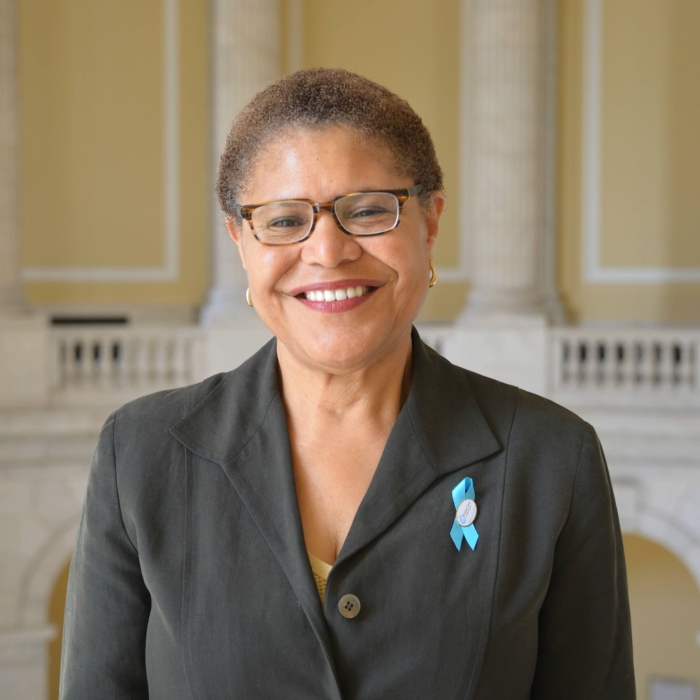
Karen Bass, the aspiring contender for L.A. Mayor, proposes to make structural investments to rebuild communities
Aiming to dramatically change the City of L.A.’s approach to public safety, Los Angeles mayoral candidate Karen Bass has unveiled a plan to reduce crime and prevent violence in neighborhoods throughout the city and especially in communities of color.
Among the main tenets of her proposal are the establishment of a community safety office within the Mayor’s Office and moving the Gang Reduction and Youth Development (GRYD) from the purview of the LAPD into the Office of Community Safety.
Bass also advocates heightening the profile, responsibility and wages of community intervention workers, investing in community-based strategies such as re-entry programs for formerly incarcerated youth and adults, and upgrading the physical appearance of neighborhoods awash in blighted conditions like illegal dumping.
This plan comes on the heels of the first phase of the public safety plan that Bass released nearly two months ago, and at the time, she indicated two more sections were coming.
“The first plan talked about the fact that crime had increased – granted it’s not to the level some people are trying to project – and it recognized that some people in some neighborhoods are not feeling safe. What I called for in that plan is for police officers that have retired or quit to be replaced. I do not call for a massive expansion of the police force, like some of the other people running for mayor.
“The other thing that plan did was acknowledged that in some neighborhoods, they would like to see an increased police presence,” said Bass, but she admitted that African American neighborhoods are not usually requesting more law enforcement, but instead desire a more comprehensive approach to public safety.
Sometimes when we have an increased police presence in our neighborhood, it doesn’t really help anything and sometimes makes things worse. That plan also called for the formation of the Community Safety Office and looking at an overall way of re-envisioning public safety in L.A.

“My strong belief is when a crime is committed, the person has to be held accountable. While we have to do that, I want to invest a tremendous of resources in preventing future crimes,” she said, adding that she has always believed that prevention was a socio-economic issue, which this phase of her plan addresses.
This second phase of her crime prevention plan also calls for bringing all city departments together – with the exception of the LAPD – to assist in crime prevention. In Bass’ opinion, departments such as Sanitation, Economic Workforce and Development, and Transportation, as well as others play critical roles in improving communities through services like trash collections, job training and painted crosswalks.
“My plan also calls for a collaboration with L.A. County and collaboration with the community. We want neighborhoods to determine what they need to be safe and that’s different in different neighborhoods,’ said Bass.
She noted that the county partnership was critical because many contributing factors impacting crime and violence are regulated by that huge agency. The foster care system, probation services, criminal justice, and general relief support all fall under the responsibility of L.A. County.

Her goal is by the end of the first year, “We would have a community vision that says what Angelenos need to feel safe. In all of the different neighborhoods,” she said.
Regarding GRYD, Bass vowed to “make a serious investment” in their work. “I don’t feel that they get the due that they deserve. They do a really good job. I want to raise their standards and I absolutely want to raise their wages. Also, they need access to mental health services because they are constantly immersed in trauma,” she declared.
In addition to elevating the role of GRYD community intervention workers, Bass hopes to expand the community safety partnerships. Currently, CSP is comprised of representatives from GRYD, LAPD and the Housing Authority of the City of L.A. and operates in 10 public housing sites throughout the city. According to Bass’ plan, a 2020 evaluation report showed the CSP improves the residents’ perception of safety and builds their trust in the officers.
In her plan, Bass wrote that she will “fully restore the expert validated ‘whole of community’ safety strategies that build teams of trusted police, community members, gang interventionists and experts to boost safety, build trust, cut police use of force, and drop violent crime – resulting in fewer arrests in the most underfunded neighborhoods of Los Angeles.”

Investment in youth is another area that Bass will emphasize. Her initiatives include partnerships with L.A. Unified School District, community colleges and four-year universities to introduce young people to social capital and networks that aid in professional growth; and obtaining commitments from private sector firms to hire and train L.A. young people, especially those from neighborhoods facing high unemployment.

Welcoming feedback on the plan, Bass encouraged the public to review it and share comments on her website.
To view Karen Bass’ crime prevention plan, visit https://karenbass.com/policies/crime-prevention/







